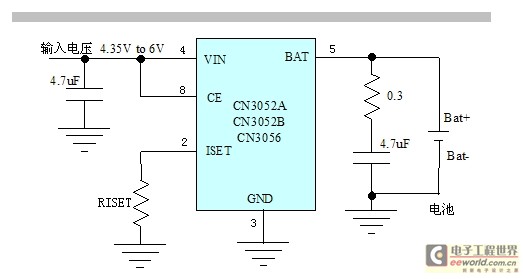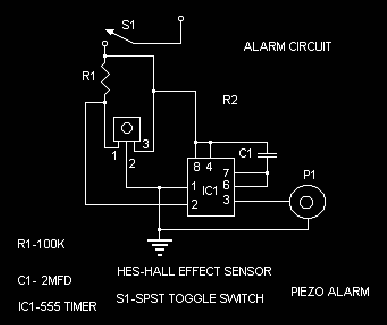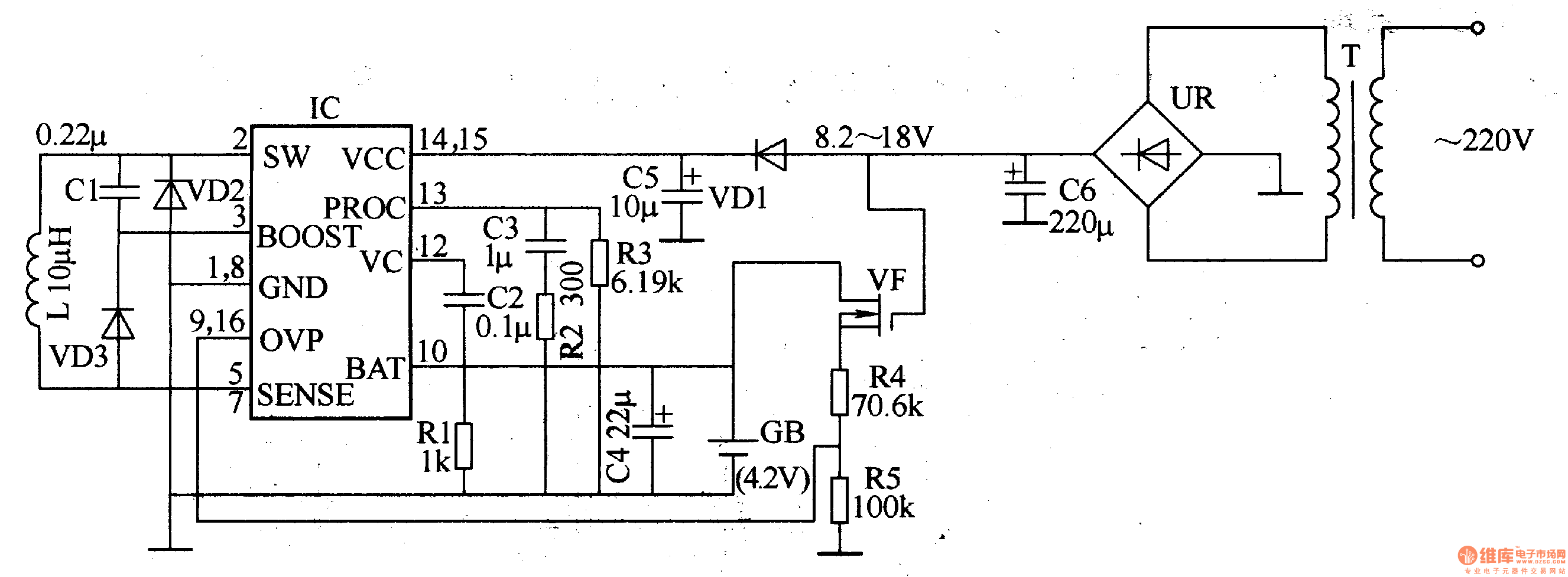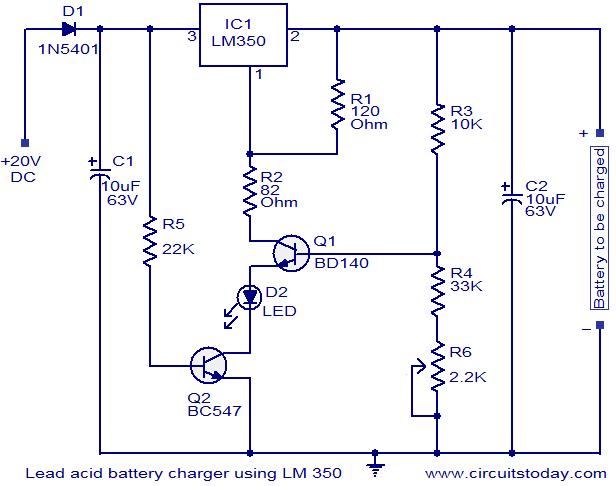
Manage the application of the chip in high-performance linear lithium battery charge

The CN3052A/CN3052B/CN3056 is a high-performance linear lithium battery management chip. It integrates a power transistor, eliminating the need for an external sense resistor and a choke flow diode for current sensing. Only a few peripheral components are required, and it complies with USB bus specifications, making it suitable for various portable devices such as chargers, MP4 players, Bluetooth earphones, and digital cameras. The output voltage is regulated to 4.2V with a precision of up to 1%. The charging current can be adjusted using an external resistor. When the input voltage is low or power is lost, the CN3052A/CN3052B/CN3056 automatically enters a low-power standby mode, consuming less than 3µA. The device begins charging when the input voltage exceeds a specific threshold, indicated by a low level on the CHRG pin. If the battery voltage is below 3V, it initiates a trickle charge; once the voltage exceeds 3V, it switches to a constant current mode. The charging current is determined by the resistance between the ISET pin and ground. When the charging current drops to a threshold indicating the end of the charging cycle, the CHRG pin transitions to a high impedance state, signaling the completion of the charge process.
The CN3052A/CN3052B/CN3056 series of chips are designed for efficient lithium battery charging applications, featuring an integrated power transistor that simplifies the circuit design by removing the need for external components like sense resistors and diodes. This integration not only reduces the overall component count but also enhances reliability and minimizes the PCB footprint, making it ideal for compact electronic devices.
The chip adheres to USB charging specifications, allowing for seamless integration into devices that utilize USB power sources. This feature is particularly beneficial for consumer electronics, including portable chargers, MP4 players, Bluetooth audio devices, and digital cameras, which are commonly charged via USB ports.
The output voltage is precisely regulated at 4.2V, which is the standard charging voltage for lithium-ion batteries. The precision of 1% ensures that the battery is charged optimally, prolonging its lifespan and enhancing performance. The adjustable charging current, controlled by an external resistor connected to the ISET pin, provides flexibility in charging rates according to the specific requirements of the application.
In terms of power management, the CN3052A/CN3052B/CN3056 features an intelligent standby mode that activates when the input voltage falls below a certain level or when power is cut off. At this point, the chip significantly reduces its current draw to less than 3µA, conserving battery life in devices that may not be in constant use.
The charging process is monitored through the CHRG pin, which indicates the status of the charging cycle. Initially, if the battery's voltage is below 3V, the chip employs a trickle charge method to safely increase the voltage. Once the battery voltage exceeds 3V, the chip transitions to a constant current charging mode, providing efficient power delivery. The transition to the end of the charging cycle is marked by a reduction in charging current, at which point the CHRG pin indicates completion by switching to a high impedance state.
Overall, the CN3052A/CN3052B/CN3056 series offers a robust solution for lithium battery management, combining ease of use, efficiency, and compliance with industry standards.CN3052A/CN3052B/CN3056 the high-performance linear lithium battery charge manages the chip. Integrate power tube within these devices, do not need sense resistor and choked flow diode of external electric current, only need few peripheral components and parts, and accord with USB bus line technical regulation, it is the battery charge of lithium t o pass USB port, is very suitable for walkie products such as various chargers and MP4 player, bluetooth earphone, digital camera, etc. Fig. 1 is a typical application circuit diagram. Fig. 2 is the internal functional block diagram of CN3052A/CN3052B/CN3056, the base pin function of the chip is shown in Table 1.
Heat modulator circuit can power consumption in device great or under the the intersection of ambient temperature and high situation the intersection of chip and temperature control in safety range, benefit the customer`s system design. Modulate the output voltage as 4. 2V, the precision is up to 1%; The charging current can be adjusted through a external resistance. As the input voltage is overlow or power down, CN3052A/CN3052B/CN3056 enters the standby mode of low power consumption automatically, the current consumption of the battery is smaller than 3uA at this moment.
Fig. 3 is the charging up synoptic diagram of CN3052A/CN3052B/CN3056. Greater than power low-voltage, measure threshold value and chip, make can input the high level of head joint into, as input voltage, CN3052A/CN3052B/CN3056 begins the battery charge correctly, CHRG base pin exports the low level, shows that charges going on. If the battery voltage is lower than 3V, precharge the battery with the trickle with charger. When the battery voltage exceeds 3V, the charger adopts the constant current mode to battery charge, the charging current is by the resistance RISET between ISET base pin and GND < 4.
2V, , CN3052A/CN3052B/CN3056 CN3052A/CN3052B/CN3056 the high-performance linear lithium battery charge manages the chip. Integrate power tube within these devices, do not need sense resistor and choked flow diode of external electric current, only need few peripheral components and parts, and accord with USB bus line technical regulation, it is the battery charge of lithium to pass USB port, is very suitable for walkie products such as various chargers and MP4 player, bluetooth earphone, digital camera, etc.
Fig. 1 is a typical application circuit diagram. Fig. 2 is the internal functional block diagram of CN3052A/CN3052B/CN3056, the base pin function of the chip is shown in Table 1. Heat modulator circuit can power consumption in device great or under the the intersection of ambient temperature and high situation the intersection of chip and temperature control in safety range, benefit the customer`s system design.
Modulate the output voltage as 4. 2V, the precision is up to 1%; The charging current can be adjusted through a external resistance. As the input voltage is overlow or power down, CN3052A/CN3052B/CN3056 enters the standby mode of low power consumption automatically, the current consumption of the battery is smaller than 3uA at this moment. Fig. 3 is the charging up synoptic diagram of CN3052A/CN3052B/CN3056. Greater than power low-voltage, measure threshold value and chip, make can input the high level of head joint into, as input voltage, CN3052A/CN3052B/CN3056 begins the battery charge correctly, CHRG base pin exports the low level, shows that charges going on.
If the battery voltage is lower than 3V, precharge the battery with the trickle with charger. When the battery voltage exceeds 3V, the charger adopts the constant current mode to battery charge, the charging current is by the resistance RISET between ISET base pin and GND < 4. 2V, , CN3052A/CN3052B/CN3056 When the charging current is reduced to charging to finish threshold value, CHRG end exports the high impedance state, show that it is over to charge cycle, it is 10% of the ch
🔗 External reference
The CN3052A/CN3052B/CN3056 series of chips are designed for efficient lithium battery charging applications, featuring an integrated power transistor that simplifies the circuit design by removing the need for external components like sense resistors and diodes. This integration not only reduces the overall component count but also enhances reliability and minimizes the PCB footprint, making it ideal for compact electronic devices.
The chip adheres to USB charging specifications, allowing for seamless integration into devices that utilize USB power sources. This feature is particularly beneficial for consumer electronics, including portable chargers, MP4 players, Bluetooth audio devices, and digital cameras, which are commonly charged via USB ports.
The output voltage is precisely regulated at 4.2V, which is the standard charging voltage for lithium-ion batteries. The precision of 1% ensures that the battery is charged optimally, prolonging its lifespan and enhancing performance. The adjustable charging current, controlled by an external resistor connected to the ISET pin, provides flexibility in charging rates according to the specific requirements of the application.
In terms of power management, the CN3052A/CN3052B/CN3056 features an intelligent standby mode that activates when the input voltage falls below a certain level or when power is cut off. At this point, the chip significantly reduces its current draw to less than 3µA, conserving battery life in devices that may not be in constant use.
The charging process is monitored through the CHRG pin, which indicates the status of the charging cycle. Initially, if the battery's voltage is below 3V, the chip employs a trickle charge method to safely increase the voltage. Once the battery voltage exceeds 3V, the chip transitions to a constant current charging mode, providing efficient power delivery. The transition to the end of the charging cycle is marked by a reduction in charging current, at which point the CHRG pin indicates completion by switching to a high impedance state.
Overall, the CN3052A/CN3052B/CN3056 series offers a robust solution for lithium battery management, combining ease of use, efficiency, and compliance with industry standards.CN3052A/CN3052B/CN3056 the high-performance linear lithium battery charge manages the chip. Integrate power tube within these devices, do not need sense resistor and choked flow diode of external electric current, only need few peripheral components and parts, and accord with USB bus line technical regulation, it is the battery charge of lithium t o pass USB port, is very suitable for walkie products such as various chargers and MP4 player, bluetooth earphone, digital camera, etc. Fig. 1 is a typical application circuit diagram. Fig. 2 is the internal functional block diagram of CN3052A/CN3052B/CN3056, the base pin function of the chip is shown in Table 1.
Heat modulator circuit can power consumption in device great or under the the intersection of ambient temperature and high situation the intersection of chip and temperature control in safety range, benefit the customer`s system design. Modulate the output voltage as 4. 2V, the precision is up to 1%; The charging current can be adjusted through a external resistance. As the input voltage is overlow or power down, CN3052A/CN3052B/CN3056 enters the standby mode of low power consumption automatically, the current consumption of the battery is smaller than 3uA at this moment.
Fig. 3 is the charging up synoptic diagram of CN3052A/CN3052B/CN3056. Greater than power low-voltage, measure threshold value and chip, make can input the high level of head joint into, as input voltage, CN3052A/CN3052B/CN3056 begins the battery charge correctly, CHRG base pin exports the low level, shows that charges going on. If the battery voltage is lower than 3V, precharge the battery with the trickle with charger. When the battery voltage exceeds 3V, the charger adopts the constant current mode to battery charge, the charging current is by the resistance RISET between ISET base pin and GND < 4.
2V, , CN3052A/CN3052B/CN3056 CN3052A/CN3052B/CN3056 the high-performance linear lithium battery charge manages the chip. Integrate power tube within these devices, do not need sense resistor and choked flow diode of external electric current, only need few peripheral components and parts, and accord with USB bus line technical regulation, it is the battery charge of lithium to pass USB port, is very suitable for walkie products such as various chargers and MP4 player, bluetooth earphone, digital camera, etc.
Fig. 1 is a typical application circuit diagram. Fig. 2 is the internal functional block diagram of CN3052A/CN3052B/CN3056, the base pin function of the chip is shown in Table 1. Heat modulator circuit can power consumption in device great or under the the intersection of ambient temperature and high situation the intersection of chip and temperature control in safety range, benefit the customer`s system design.
Modulate the output voltage as 4. 2V, the precision is up to 1%; The charging current can be adjusted through a external resistance. As the input voltage is overlow or power down, CN3052A/CN3052B/CN3056 enters the standby mode of low power consumption automatically, the current consumption of the battery is smaller than 3uA at this moment. Fig. 3 is the charging up synoptic diagram of CN3052A/CN3052B/CN3056. Greater than power low-voltage, measure threshold value and chip, make can input the high level of head joint into, as input voltage, CN3052A/CN3052B/CN3056 begins the battery charge correctly, CHRG base pin exports the low level, shows that charges going on.
If the battery voltage is lower than 3V, precharge the battery with the trickle with charger. When the battery voltage exceeds 3V, the charger adopts the constant current mode to battery charge, the charging current is by the resistance RISET between ISET base pin and GND < 4. 2V, , CN3052A/CN3052B/CN3056 When the charging current is reduced to charging to finish threshold value, CHRG end exports the high impedance state, show that it is over to charge cycle, it is 10% of the ch
🔗 External reference





